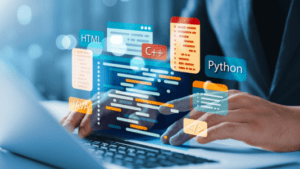Table of contents:
Introduction
- 1.1 Background
- 1.2 Research Objective
- 1.3 Methodology
Understanding Pair Programming
- 2.1 Definition and Principles
- 2.2 Roles and Responsibilities
- 2.3 Common Practices and Techniques
Improved Code Quality
- 3.1 Code Review and Feedback
- 3.2 Reduced Defects and Bugs
- 3.3 Continuous Refactoring
- 3.4 Increased Test Coverage
Knowledge Sharing and Learning
- 4.1 Sharing Expertise and Skills
- 4.2 Cross-Training and Onboarding
- 4.3 Distributed Knowledge and Reduced Bus Factor
- 4.4 Mentoring and Skill Development
Enhanced Communication and Collaboration
- 5.1 Real-time Discussion and Problem Solving
- 5.2 Increased Team Cohesion
- 5.3 Reduced Miscommunication and Misunderstanding
- 5.4 Effective Conflict Resolution
Increased Productivity and Efficiency
- 6.1 Reduced Rework and Debugging Time
- 6.2 Faster Problem Solving
- 6.3 Parallel Programming and Multitasking
- 6.4 Improved Decision Making
Improved Developer Satisfaction and Well-being
- 7.1 Reduced Isolation and Loneliness
- 7.2 Enhanced Job Satisfaction
- 7.3 Collaboration and Social Interaction
- 7.4 Reduced Burnout and Stress
Challenges and Mitigation Strategies
- 8.1 Implementation Challenges
- 8.2 Addressing Personality and Compatibility Issues
- 8.3 Balancing Autonomy and Collaboration
- 8.4 Remote Pair Programming
Conclusion
- 9.1 Summary of Benefits
- 9.2 Recommendations for Implementation
- 9.3 Future Directions of Research
1.1 Background
Pair programming is a software development practice that involves two programmers working together at a single workstation. It is a collaborative approach that has gained popularity in the software industry due to its potential benefits for developers and organizations. Pair programming is rooted in the agile methodology and promotes teamwork, communication, and shared accountability in the development process.
1.2 Research Objective
The objective of this research is to explore and analyze the benefits of pair programming in software development comprehensively. By examining various aspects of pair programming, such as improved code quality, knowledge sharing, enhanced communication, increased team cohesion, and improved developer skills, we aim to provide a thorough understanding of the advantages it offers. This research seeks to support its findings with empirical evidence, case studies, and real-world examples to demonstrate the effectiveness of pair programming in improving software development outcomes.
1.3 Methodology
To achieve the research objective, a comprehensive review of existing literature on pair programming will be conducted. Empirical studies, case studies, and industry reports will be analyzed to gather evidence supporting the benefits of pair programming. The findings will be synthesized to present a holistic view of the advantages and potential challenges associated with pair programming in software development.
Understanding Pair Programming
2.1 Definition and Principles
Pair programming involves two programmers working together as a team on the same workstation. One programmer assumes the role of the “driver” who writes the code, while the other takes the role of the “observer” or “navigator,” providing input, reviewing the code, and offering suggestions. The roles can be switched periodically to ensure equal participation and knowledge sharing.
2.2 Roles and Responsibilities
In pair programming, both developers actively engage in the coding process. The driver focuses on writing the code, while the navigator provides feedback, identifies potential issues, and suggests improvements. The navigator also has the responsibility of ensuring adherence to coding standards and best practices.
2.3 Common Practices and Techniques
Pair programming can be implemented in different ways, depending on the team’s preferences and project requirements. Some common practices include time-boxed pairs, where developers switch roles after a fixed time interval, and ping-pong pairing, where one programmer writes a test, and the other implements the code to pass the test. The chosen practices should align with the team’s goals and the project’s needs.
Improved Code Quality
3.1 Code Review and Feedback
Pair programming serves as a continuous code review process since both programmers actively review each other’s code during development. This immediate feedback loop helps identify errors, logical flaws, and potential improvements, leading to higher code quality. The collaborative nature of pair programming ensures that issues are caught early, reducing the likelihood of bugs and defects in the final product.
3.2 Reduced Defects and Bugs
The constant collaboration and code review in pair programming contribute to reducing defects and bugs in the software. With two sets of eyes reviewing the code simultaneously, errors are caught more promptly, minimizing the chances of introducing costly mistakes. The collaborative approach also facilitates identifying edge cases and improving error handling, resulting in more robust and reliable code.
3.3 Continuous Refactoring
Pair programming promotes continuous refactoring, which involves improving the code’s structure, readability, and maintainability without changing its functionality. As both programmers actively participate in the development process, they can collectively identify areas for refactoring and implement improvements. This ongoing refactoring ensures that the codebase remains clean, extensible, and easier to maintain in the long run.
3.4 Increased Test Coverage
Pair programming encourages thorough testing practices by incorporating testing into the development process from the beginning. Both programmers can collaborate on designing and implementing test cases, ensuring comprehensive test coverage. By testing code in real-time, pair programming minimizes the chances of inadequate or incomplete testing, leading to a more reliable and stable software product.
Knowledge Sharing and Learning
4.1 Sharing Expertise and Skills
Pair programming enables the sharing of expertise and skills between team members. Junior developers can learn from more experienced programmers, gaining insights into best practices, design patterns, and coding techniques. Simultaneously, experienced developers can benefit from the fresh perspectives and innovative ideas brought by their pair, fostering a culture of continuous learning and growth within the team.
4.2 Cross-Training and Onboarding
Pair programming facilitates cross-training and onboarding of new team members. By pairing experienced developers with newcomers, knowledge transfer occurs organically. New team members can quickly get up to speed with project-specific knowledge, coding standards, and the overall development process. This accelerates the onboarding process, reduces ramp-up time, and ensures a smooth transition for new hires.
4.3 Distributed Knowledge and Reduced Bus Factor
In pair programming, knowledge about the codebase is distributed among multiple team members. This mitigates the risk of a single point of failure and reduces the bus factor—the impact on a project if a key individual leaves the team. As multiple developers are familiar with different parts of the codebase, the team becomes less dependent on specific individuals, improving the project’s resilience and maintainability.
4.4 Mentoring and Skill Development
Pair programming creates an environment conducive to mentoring and skill development. Junior developers working with more experienced programmers can learn from their expertise and receive guidance in real-time. This mentorship helps junior developers grow their skills, gain confidence, and become more independent developers over time. Additionally, experienced programmers can refine their leadership and communication skills by mentoring their pairs, fostering a culture of knowledge sharing within the team.
Enhanced Communication and Collaboration
5.1 Real-time Discussion and Problem Solving
Pair programming encourages real-time discussion and problem-solving. The constant interaction between programmers facilitates immediate clarification of requirements, design decisions, and implementation strategies. This leads to a shared understanding of the problem domain, better alignment between team members, and faster resolution of technical challenges or roadblocks.
5.2 Increased Team Cohesion
Pair programming strengthens team cohesion by fostering a sense of collaboration and shared responsibility. Developers working in pairs build a rapport, develop trust, and create a cohesive team environment. This collaborative mindset extends beyond pair programming sessions, leading to better teamwork, increased knowledge sharing, and improved overall team dynamics.
5.3 Reduced Miscommunication and Misunderstanding
Miscommunication and misunderstandings can lead to costly delays and rework in software development projects. Pair programming minimizes the chances of miscommunication as both programmers are actively engaged in the development process. They can clarify requirements, discuss implementation approaches, and resolve ambiguities in real-time, reducing the likelihood of misinterpretations and resulting in more accurate and aligned implementations.
5.4 Effective Conflict Resolution
Pair programming encourages open and constructive communication between developers, which can help resolve conflicts effectively. Disagreements and differing viewpoints can be addressed immediately, fostering a culture of respectful debate and collaboration. By resolving conflicts at the earliest stages, pair programming prevents misunderstandings from escalating and positively impacts the team’s overall productivity and harmony.
Increased Productivity and Efficiency
6.1 Reduced Rework and Debugging Time
Pair programming contributes to a reduction in rework and debugging time. With two programmers actively reviewing code during development, errors and defects are caught early, minimizing the need for extensive debugging later. The collaborative nature of pair programming also promotes better problem-solving, ensuring that potential issues are addressed before they escalate into larger problems.
6.2 Faster Problem Solving
When faced with complex problems or challenges, two minds working together can often arrive at a solution faster than a single developer working alone. Pair programming leverages the collective intelligence of the pair to tackle problems more efficiently. The ability to brainstorm ideas, share perspectives, and pool their knowledge and skills leads to quicker problem resolution and faster progress in the development process.
6.3 Parallel Programming and Multitasking
Pair programming enables parallel programming and multitasking, enhancing productivity. While one programmer focuses on writing code, the other can perform research, look up documentation, or handle ancillary tasks such as configuration or deployment. This parallel approach maximizes the team’s efficiency and optimizes time utilization, allowing multiple aspects of development to progress simultaneously.
6.4 Improved Decision Making
Pair programming fosters better decision-making by leveraging the collective expertise and perspectives of the pair. When faced with design choices or implementation decisions, two programmers can discuss and evaluate different options, weigh their pros and cons, and make informed decisions collaboratively. This reduces the likelihood of hasty or suboptimal choices and results in better overall software design and implementation.
Improved Developer Satisfaction and Well-being
7.1 Reduced Isolation and Loneliness
Software development can be a solitary endeavor, with developers often spending long hours working alone. Pair programming addresses this isolation by promoting collaboration and social interaction. Working in pairs provides companionship and reduces feelings of loneliness, contributing to improved developer satisfaction and overall well-being.
7.2 Enhanced Job Satisfaction
Pair programming has been associated with increased job satisfaction among developers. The collaborative nature of pair programming fosters a sense of accomplishment, as developers can see the immediate impact of their work and receive real-time feedback. Pair programming also promotes a learning culture and provides opportunities for personal growth, which are key factors in enhancing job satisfaction.
7.3 Collaboration and Social Interaction
Pair programming encourages collaboration and social interaction within development teams. By working closely together, developers build stronger relationships, share experiences, and create a supportive work environment. This collaboration not only improves the quality of the code but also enhances team cohesion and morale, leading to a positive and engaging work atmosphere.
7.4 Reduced Burnout and Stress
Pair programming can help alleviate burnout and reduce stress levels among developers. The collaborative nature of pair programming distributes the workload and allows developers to share responsibilities, preventing individuals from feeling overwhelmed or overburdened. Additionally, the constant support and feedback provided by pairs can reduce the pressure and stress associated with solitary decision-making, leading to improved mental well-being.
Challenges and Mitigation Strategies
8.1 Implementation Challenges
Implementing pair programming may face initial resistance, as it requires a cultural shift and adjustment in working practices. Some developers may be skeptical or uncomfortable with the idea of constant collaboration. To address this challenge, organizations can introduce pair programming gradually, provide training and education on its benefits, and create a supportive environment that encourages experimentation and learning.
8.2 Addressing Personality and Compatibility Issues
Pair programming pairs individuals with different personalities and working styles. It is crucial to consider compatibility when forming pairs to ensure effective collaboration. Open communication, regular rotation of pairs, and creating an environment of respect and understanding can help mitigate personality conflicts and maximize the benefits of pair programming.
8.3 Balancing Autonomy and Collaboration
Pair programming involves finding the right balance between autonomy and collaboration. Developers need opportunities for individual thinking and problem-solving, along with collaborative sessions. Organizations should encourage pairs to find a rhythm that allows for both independent work and joint decision-making, empowering developers to contribute their unique perspectives while benefiting from collaborative efforts.
8.4 Remote Pair Programming
Remote work settings can present challenges for pair programming, as physical presence is replaced by virtual collaboration. However, with the help of appropriate tools and technologies, remote pair programming can be facilitated effectively. Organizations can provide remote pairing guidelines, leverage video conferencing and screen-sharing tools, and establish communication channels to overcome the geographical barriers and enable successful remote pair programming.
Conclusion
9.1 Summary of Benefits
Pair programming offers numerous benefits in software development. It leads to improved code quality, reduced defects and bugs, continuous refactoring, and increased test coverage. It facilitates knowledge sharing, cross-training, and mentoring, enhancing the skills and expertise of individual developers. Pair programming improves communication and collaboration, increases team cohesion, and fosters effective conflict resolution. It boosts productivity and efficiency, reduces rework and debugging time, and promotes faster problem-solving. Pair programming contributes to developer satisfaction, well-being, and mitigates burnout and stress.
9.2 Recommendations for Implementation
Based on the findings of this research, organizations are recommended to consider implementing pair programming in their software development processes. It is advised to start with small-scale pilot projects, provide adequate training and support, and gradually expand the practice across teams. Establishing a positive and collaborative work environment, addressing compatibility issues, and leveraging appropriate tools and technologies are crucial for successful pair programming implementation.
9.3 Future Directions of Research
This research opens avenues for future exploration of pair programming in different contexts. Further research can investigate the impact of pair programming on specific domains, project sizes, and team compositions. Comparative studies can be conducted to analyze the cost-effectiveness of pair programming and its long-term benefits. Additionally, exploring the effectiveness of pair programming in emerging software development practices, such as DevOps or machine learning, can provide valuable insights into its application in evolving development methodologies.



